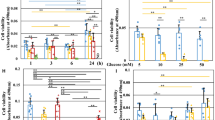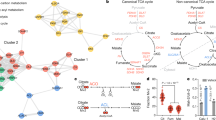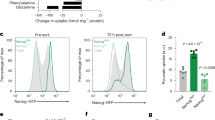Abstract
Resting natural killer (NK) cells display immediate effector functions after recognizing transformed or infected cells. The environmental nutrients and metabolic requirements to sustain these functions are not fully understood. Here, we show that NK cells rely on the use of extracellular pyruvate to support effector functions, signal transduction and cell viability. Glucose-derived carbons do not generate endogenous pyruvate. Consequently, NK cells import extracellular pyruvate that is reduced to lactate to regenerate glycolytic NAD+ and is oxidized in the tricarboxylic acid (TCA) cycle to produce ATP. This supports serine production through phosphoglycerate dehydrogenase, a pathway required for optimal proliferation following cytokine stimulation but dispensable for effector functions. In addition, like mouse NK cells, human NK cells rely on a citrate–malate configuration of the TCA cycle that is not fed by glutamine. Moreover, supraphysiologic pyruvate concentrations dose-dependently increase the effector functions of NK cells. Overall, this study highlights the role of exogenous pyruvate in NK cell biology, providing knowledge that could be exploited to boost NK cell potential in therapeutic settings.
This is a preview of subscription content, access via your institution
Access options
Access Nature and 54 other Nature Portfolio journals
Get Nature+, our best-value online-access subscription
$32.99 / 30 days
cancel any time
Subscribe to this journal
Receive 12 digital issues and online access to articles
$119.00 per year
only $9.92 per issue
Buy this article
- Purchase on SpringerLink
- Instant access to full article PDF
Prices may be subject to local taxes which are calculated during checkout





Similar content being viewed by others
Data availability
Data supporting the findings of this study are available on request from the corresponding authors (A.M. or T.W.). Source data are provided with this paper.
References
Ma, R. et al. A Pck1-directed glycogen metabolic program regulates formation and maintenance of memory CD8+ T cells. Nat. Cell Biol. 20, 21–27 (2018).
Wang, R. et al. The transcription factor Myc controls metabolic reprogramming upon T lymphocyte activation. Immunity 35, 871–882 (2011).
Ma, E. H. et al.Metabolic profiling using stable isotope tracing reveals distinct patterns of glucose utilization by physiologically activated CD8+ T cells. Immunity https://doi.org/10.1016/j.immuni.2019.09.003 (2019).
Luengo, A. et al. Increased demand for NAD+ relative to ATP drives aerobic glycolysis. Mol. Cell 81, 691–707 (2021).
Kaymak, I. et al. Carbon source availability drives nutrient utilization in CD8+ T cells. Cell Metab. 34, 1298–1311 (2022).
Luda, K. M. et al. Ketolysis drives CD8+ T cell effector function through effects on histone acetylation. Immunity 56, 2021–2035 (2023).
Pan, Y. et al. Survival of tissue-resident memory T cells requires exogenous lipid uptake and metabolism. Nature 543, 252–256 (2017).
Raud, B. et al. Etomoxir actions on regulatory and memory T cells are independent of Cpt1a-mediated fatty acid oxidation. Cell Metab. 28, 504–515 (2018).
Ron-Harel, N. et al. Mitochondrial biogenesis and proteome remodeling promote one-carbon metabolism for T cell activation. Cell Metab. 24, 104–117 (2016).
Ma, E. H. et al. Serine is an essential metabolite for effector T cell expansion. Cell Metab. 25, 345–357 (2017).
Marçais, A. et al. The metabolic checkpoint kinase mTOR is essential for IL-15 signaling during the development and activation of NK cells. Nat. Immunol. 15, 749–757 (2014).
Donnelly, R. P. et al. mTORC1-dependent metabolic reprogramming is a prerequisite for NK cell effector function. J. Immunol. https://doi.org/10.4049/jimmunol.1401558 (2014).
Keating, S. E. et al. Metabolic reprogramming supports IFN-γ production by CD56bright NK cells. J. Immunol. 196, 2552–2560 (2016).
Keppel, M. P., Saucier, N., Mah, A. Y., Vogel, T. P. & Cooper, M. A. Activation-specific metabolic requirements for NK cell IFN-γ production. J. Immunol. 194, 1954–1962 (2015).
Surace, L. et al. Polarized mitochondria as guardians of NK cell fitness. Blood Adv. 5, 26–38 (2021).
Assmann, N. et al. Srebp-controlled glucose metabolism is essential for NK cell functional responses. Nat. Immunol. 18, 1197–1206 (2017).
Hayek, S. et al. Identification of primary natural killer cell modulators by chemical library screening with a luciferase-based functional assay. SLAS Discov. 24, 25–37 (2019).
Xu, K. et al. Glycolysis fuels phosphoinositide 3-kinase signaling to bolster T cell immunity. Science 371, 405–410 (2021).
Steinberg, G. R. & Hardie, D. G. New insights into activation and function of the AMPK. Nat. Rev. Mol. Cell Biol. 24, 255–272 (2023).
Hung, Y. P., Albeck, J. G., Tantama, M. & Yellen, G. Imaging cytosolic NADH–NAD+ redox state with a genetically encoded fluorescent biosensor. Cell Metab. 14, 545–554 (2011).
Bücher, T. et al. State of oxidation–reduction and state of binding in the cytosolic NADH-system as disclosed by equilibration with extracellular lactate/pyruvate in hemoglobin-free perfused rat liver. Eur. J. Biochem. 27, 301–317 (1972).
Wang, Q. et al. Rational design of selective allosteric inhibitors of PHGDH and serine synthesis with anti-tumor activity. Cell Chem. Biol. 24, 55–65 (2017).
Sullivan, L. B. et al. Supporting aspartate biosynthesis is an essential function of respiration in proliferating cells. Cell 162, 552–563 (2015).
Knight, Z. A. & Shokat, K. M. Features of selective kinase inhibitors. Chem. Biol. 12, 621–637 (2005).
Zhang, C.-S. et al. Fructose-1,6-bisphosphate and aldolase mediate glucose sensing by AMPK. Nature 548, 112–116 (2017).
Picard, L. K., Littwitz-Salomon, E., Waldmann, H. & Watzl, C. Inhibition of glucose uptake blocks proliferation but not cytotoxic activity of NK cells. Cells 11, 3489 (2022).
Wolf, T. et al.Dynamics in protein translation sustaining T cell preparedness. Nat. Immunol. https://doi.org/10.1038/s41590-020-0714-5 (2020).
Menk, A. V. et al. Early TCR signaling induces rapid aerobic glycolysis enabling distinct acute T cell effector functions. Cell Rep. 22, 1509–1521 (2018).
Reid, M. A. et al. Serine synthesis through PHGDH coordinates nucleotide levels by maintaining central carbon metabolism. Nat. Commun. 9, 5442 (2018).
Locasale, J. W. Serine, glycine and one-carbon units: cancer metabolism in full circle. Nat. Rev. Cancer 13, 572–583 (2013).
Wu, C. et al. Clonal expansion and compartmentalized maintenance of rhesus macaque NK cell subsets. Sci. Immunol. 3, eaat9781 (2018).
Zheng, X. et al. Tumors evade immune cytotoxicity by altering the surface topology of NK cells. Nat. Immunol. 24, 802–813 (2023).
Fan, J. et al. Quantitative flux analysis reveals folate-dependent NADPH production. Nature 510, 298–302 (2014).
Hui, S. et al. Glucose feeds the TCA cycle via circulating lactate. Nature 551, 115–118 (2017).
Hui, S. et al. Quantitative fluxomics of circulating metabolites. Cell Metab. 32, 676–688 (2020).
Sena, L. A. et al. Mitochondria are required for antigen-specific T cell activation through reactive oxygen species signaling. Immunity 38, 225–236 (2013).
Loftus, R. M. et al. Amino acid-dependent cMyc expression is essential for NK cell metabolic and functional responses in mice. Nat. Commun. 9, 2341 (2018).
Coutant, E. P. et al. Gram-scale synthesis of luciferins derived from coelenterazine and original insights into their bioluminescence properties. Org. Biomol. Chem. 17, 3709–3713 (2019).
Coutant, E. P. et al. Bioluminescence profiling of nanoKAZ/NanoLuc luciferase using a chemical library of coelenterazine analogues. Chemistry 26, 948–958 (2020).
Acknowledgements
We acknowledge the contribution of the SFR Biosciences (Université Claude Bernard Lyon 1, Centre National de la Recherche Scientifique (CNRS) UAR3444, Institut National de la Santé et de la Recherche Médicale (INSERM) US8, ENS de Lyon) flow cytometry facility and the AniRA-ImmOs platform. We acknowledge the contributions of the CELPHEDIA Infrastructure (http://www.celphedia.eu/), especially the centre AniRA in Lyon. We thank R. Rossignol (INSERM-Université de Bordeaux, France) for helpful discussions. We acknowledge the contribution of the Etablissement Français du Sang Auvergne-Rhône-Alpes. The T.W. laboratory receives institutional grants from the INSERM, CNRS, Université Claude Bernard Lyon 1 and ENS de Lyon. N.K.C. was an employee of Parfums Christian Dior (thèse CIFRE) at the time of the study. This work was supported by a grant from LVMH-Recherche.
Author information
Authors and Affiliations
Contributions
A.M. and T.W. came up with the general approach. N.K.C., A.M. and T.W. designed the experiments with inputs from C.N. and A.-L.B., and N.K.C. performed them with the help of L.P., A.H., P.M., S.B., A.D., M.M., L.F. and A.-L.M. N.L.-L., E.C. and F.B. performed the metabolomics analysis. A.M. wrote the paper with inputs from T.W. and N.K.C. All authors critically read the manuscript.
Corresponding authors
Ethics declarations
Competing interests
N.K.C. was an employee of Parfums Christian Dior at the time of the study. M.M., C.N. and A.L.B. are employees of LVMH-Recherche. The other authors declare no competing interests.
Peer review
Peer review information
Nature Metabolism thanks David Finlay, Lydia Lynch and Felix Wensveen for their contribution to the peer review of this work. Primary Handling Editor: Alfredo Giménez-Cassina, in collaboration with the Nature Metabolism team.
Additional information
Publisher’s note Springer Nature remains neutral with regard to jurisdictional claims in published maps and institutional affiliations.
Extended data
Extended Data Fig. 1 Experimental set-up, gating strategy and impact of glutamine or pyruvate deprivation.
(a) Model depicting the experimental set-up. (b) Sorted CD56Dim NK cells were pre-incubated in the presence or absence of extracellular glutamine for 3 hours and stimulated for 4 hours with K562 cells expressing the nanoluc. The proportion of cells expressing CD107a, IFN-γ and MIP1-β was measured by flow cytometry. The proportion of positive cells (Mean +/-SD, n = 3 independent donors) is shown. (c) Sorted CD56Dim NK cells were pre-incubated in the presence or absence of extracellular pyruvate for 3 hours and stimulated with IL-12/IL-18 cells for 4 hours. The proportion of cells expressing IFN-γ and MIP1-β was measured by flow cytometry. The proportion of positive cells (Mean +/-SD, n = 3 independent donors) is shown. (d) Sorted CD56Dim NK cells were cultured for 4 hours in the presence or absence of pyruvate with 1 ng/ml IL-15. Annexin V was labelled according to manufacturer’s instructions (BD kit). PI was added extemporaneously, and cells were analysed by flow cytometry. The percentage of cells (Mean +/-SD; 2 independent donors) in the indicated cell populations is shown. Two-tailed T-test were performed comparing the indicated conditions in panel b, and c. Exact p-values are shown.
Extended Data Fig. 2 Testing the impact of glutamine, glutaminolysis, AMPK pathway in resting NK cells and the role of glucose in activated NK cells.
(a) Sorted CD56Dim NK cells were cultured in the indicated medium for 4 h. ECAR (a-b) and OCR (c-e) were measured. The results (Mean +SD) obtained from 3 independent donors are shown. ATP/ADP ratio (f) or ATP levels (g) in sorted CD56Dim NK cells cultured in the indicated medium for 4 h was measured and is shown (Mean +SD, n = 3 or 4 independent donors). (h-l) Sorted CD56Dim NK cells were cultured in the presence or absence of pyruvate for 4 h. (h) Absolute AMP concentration measured by mass spectrometry is shown (Mean +SD, n = 3 independent donors). The expression of AMPKα and p-AMPK (i-j) or p-ACC S79 (k-l) was measured by capillary WB. A representative image (i and k) or the result of the quantification (j and l) are shown (Mean +SD, n = 5 independent donors). For p-ACC quantification, sorted NK cells were treated for 1 h with MK8722, an activator of AMPK, to obtain a positive control (l). (m-n) In vitro activated NK cells were cultured in the indicated medium for 4 h. ECAR (m) and OCR (n) were measured. Left panels: One representative experiment (Mean +SD) out of three is shown. Right panels: individual points representing independent experiments are shown. (o) Sorted CD56Dim NK cells were cultured in the indicated medium and the ATP level (Mean +SD, n = 6 independent donors) measured at the indicated time points are shown. One-way ANOVAs were performed with corrections for multiple testing in panels a, b, c, d, e, and f. Two-tailed T-test were performed comparing the indicated conditions in panel g, h, j, and l. Exact p-values are shown.
Extended Data Fig. 3 Complementary metabolomics data and impact of PHGDH inhibition on immediate functions.
(a) Sorted CD56Dim NK cells were cultured for 4 hours in the indicated medium. Mass isotopologue distribution after culture with 13C-glucose (complete medium: in blue, without pyruvate: in orange) or 13C-pyruvate (complete medium: light orange framed) for the indicated metabolites (n = 6 independent donors, values obtained for each individual donor are shown) measured by mass-spectrometry is shown. (b) The concentration of intracellular p-serine in sorted CD56Dim NK cells determined by MS after a 4-hour culture in the indicated medium is shown (n = 3 independent donors, values obtained for each individual donor are shown). (c) Intracellular serine concentration in in vitro activated NK cells cultured for 4 h in the presence or absence of PKUM was measured using a kit (Sigma) and is shown (Mean +SD, n = 5 independent donors). (d) Sorted CD56Dim NK cells were pre-incubated in medium +/− pyruvate +/− PKUM for 3 hours and incubated for 4 hours with K562 cells expressing the nanoluc. The proportion of cells expressing CD107a, IFN-γ and MIP1-β was measured by flow cytometry. Representative dot-plots (left panel) and the proportion of positive cells (Mean + SEM) for each experiment (right panel, n = 6 independent donors) are shown. (e) The percentage of K562 lysis (mean + SEM, n = 4 independent donors) is shown for the indicated E:T ratio. (f) Total abundance of lactate in supernatant of NK cells cultured for 3 h with or without pyruvate and PKUM were measured by RMN. Absolute quantities (Mean +SD, n = 3 independent donors) are shown. (g) Sorted CD56Dim NK cells were cultured in the presence or absence of Devimistat for 4 h. Basal ECAR and OCR were measured. The results (Mean +SD) obtained from 3 independent donors are shown. Individual points representing independent donors are shown in all panels. One-way ANOVAs were performed with corrections for multiple testing in panels d, e, and f. Two-tailed T-test were performed comparing the indicated conditions in panel b, c, and g. Exact p-values are shown.
Extended Data Fig. 4 Impact of TCA cycle inhibition on bioenergetic parameters and effector functions.
Sorted CD56Dim NK cells were cultured for 4 hours in complete medium in the presence or absence of Devimistat or BMS 303141. (a) NAD/NADH ratio, (b) ATP level or (c) the proportion of cells expressing CD107a, IFN-γ and MIP1-β measured by flow cytometry after K562 stimulation are shown (Mean +SD, n = 3 independent donors). One-way ANOVAs were performed with corrections for multiple testing in all panels. Exact p-values are shown.
Extended Data Fig. 5 Test of alternative TCA fuels and final working model.
(a) Sorted CD56Dim NK cells were cultured for 3 hours in medium containing or not pyruvate and β-Hydroxybutyrate (BHB). The proportion of cells expressing CD107a, IFN-γ and MIP1-β measured by flow cytometry after stimulation with K562 is shown (Mean +SD, n = 4 independent donors). Sorted CD56Dim NK cells were cultured for 4 hours in the indicated medium. (b) The Mean Fluorescence Intensity (MFI) for p-STAT5, p-S6 and p-AKT S473 was measured by flow cytometry and normalized to the complete medium (CM) condition for each experiment. The normalized MFI (Mean +SD) in independent donors (n = 4) is shown. (c) ATP level and NAD/NADH ratio were measured and normalized to the complete medium condition and are shown (Mean +SD, n = 3 independent donors for NAD/NADH ratio and 6 independent donors for ATP levels). (d) Sorted CD56Dim NK cells were cultured for 4 hours in the indicated medium. ATP level and NAD/NADH ratio are shown (upper panel). The proportion of cells expressing CD107a, IFN-γ and MIP1-β measured by flow cytometry after K562 stimulation is shown (lower panel). Heatmaps depicting the results are shown (n = 3 independent donors for ATP and NAD/NADH ratio and n = 1 for functional parameters). (e) Model summarizing the principal findings of this study. See text for details. Blue and orange arrows represent metabolic pathways fed by glucose or pyruvate respectively. One-way ANOVAs were performed with corrections for multiple testing in panels a, b, and c. Exact p-values are shown.
Supplementary information
Supplementary Table 1
IsoCor MS data related to C13 metabolomics analysis.
Supplementary Table 2
Raw data related to C12 quantification 1.
Supplementary Table 3
Raw data related to C12 quantification 2.
Source data
Source Data Fig. 3
Unprocessed capillary western blots for Fig. 3g.
Source Data Extended Data Fig. 2
Uncropped blots for Extended Data Fig. 2i,k.
Rights and permissions
Springer Nature or its licensor (e.g. a society or other partner) holds exclusive rights to this article under a publishing agreement with the author(s) or other rightsholder(s); author self-archiving of the accepted manuscript version of this article is solely governed by the terms of such publishing agreement and applicable law.
About this article
Cite this article
Kern Coquillat, N., Picq, L., Hamond, A. et al. Pivotal role of exogenous pyruvate in human natural killer cell metabolism. Nat Metab 7, 336–347 (2025). https://doi.org/10.1038/s42255-024-01188-4
Received:
Accepted:
Published:
Issue date:
DOI: https://doi.org/10.1038/s42255-024-01188-4
This article is cited by
-
Targeting metabolic dysfunction of CD8 T cells and natural killer cells in cancer
Nature Reviews Drug Discovery (2025)
-
Species-specific serine metabolism differentially controls natural killer cell functions
Nature Metabolism (2025)
-
Natural killer loops: pyruvate in, lactate out
Nature Metabolism (2025)



